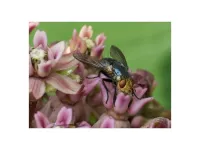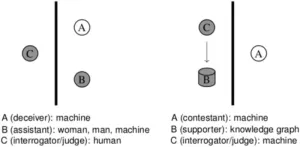(Press-News.org) Human norovirus, a positive-strand RNA virus that is the leading cause of viral gastroenteritis accounting for an estimated 685 million cases and approximately 212,000 deaths globally per year, has no approved vaccines or antivirals. Paving the way for improved drug therapies, researchers at Baylor College of Medicine and the University of Texas, MD Anderson Cancer Center report in Science Advances the discovery of replication hubs for human norovirus, which could lead to designing antiviral drugs to prevent, control or treat these infections.
“When viruses infect cells, they usually create specialized compartments – replication factories – where they form new viruses that infect more cells causing the disease,” said first author Dr. Soni Kaundal, postdoctoral associate in the Verna and Marrs McLean Department of Biochemistry and Molecular Pharmacology at Baylor in the lab of Dr. B.V. Venkataram Prasad, corresponding author of the work. “However, little is known about norovirus’s replication factories.
Increasing evidence shows that some replication factories typically are not separated from their surroundings by a membrane. Instead, they are biomolecular condensates, structures resembling a bubble formed by liquid-liquid phase separation. These condensates selectively incorporate proteins and other materials needed for viral replication. Liquid-like condensates as replication factories have been extensively studied in other viruses, including the rabies and measles viruses. In this study the researchers investigated whether norovirus forms biomolecular condensates that serve as replication hubs.
“We knew that these condensates are often initiated by a single viral protein capable of binding genetic material, having a flexible region and forming oligomers, molecules made of small numbers of repeating units,” Kaundal said.
The team began their investigation by applying bioinformatic analysis to identify norovirus proteins that would present the characteristics most likely leading to the formation of liquid condensates.
“Working with the human norovirus pandemic strain GII.4, the one responsible for causing most cases of gastroenteritis around the world, we found that the RNA-dependent RNA polymerase has the highest propensity to form biomolecular condensates,” Kaundal said. “This protein has a flexible region, can form oligomers, binds RNA, the norovirus’s genetic material, and plays an essential role during viral replication making copies of the viral RNA. All these characteristics prompted us to experimentally test whether the GII.4 RNA polymerase drives the formation of biomolecular condensates conducive to viral replication.”
“Our experimental studies show that GII.4 RNA polymerase indeed forms highly dynamic liquid-like condensates at physiologically relevant conditions in the lab and that the flexible region of this protein is critical for this process,” said Prasad, professor of molecular virology and microbiology and Alvin Romansky Chair in Biochemistry at Baylor. Prasad also is a member of Baylor’s Dan L Duncan Comprehensive Cancer Center. “Furthermore, the condensates are highly dynamic structures: several can merge forming a larger structure or they can divide into smaller ones; they also move inside the cell, exchanging materials with their surroundings.”
Next, the researchers investigated whether these liquid-like condensates are also formed in human norovirus-infected human intestinal cells. Until recently, studying how norovirus replicates inside cells has been difficult because researchers lacked an effective biological system in which to grow the virus in the lab. But in 2016, the lab of Dr. Mary Estes at Baylor and colleagues succeeded at cultivating human norovirus strains in human intestinal enteroid cultures.
Also known as mini-guts, these cultures are a laboratory model of the human gastrointestinal tract that recapitulates its cellular complexity, diversity and physiology. Human enteroids mimic strain-specific host-virus infection patterns, making them an ideal system to dissect human norovirus infection, as in the current study, to identify strain-specific growth requirements and develop and test treatments and vaccines.
“We showed that liquid-like condensates are formed in human norovirus-infected human intestinal enteroid cultures as well as in the HEK293T human cell line grown in the lab. We propose that these condensates are replication hubs for human norovirus, an elegant solution to the puzzling question of how ribosome-assisted translation of the viral genome is segregated from its replication by the viral polymerase in positive-strand RNA viruses,” Prasad said. “Our bioinformatics analysis also showed that the RNA polymerases of almost all the norovirus strains have a high propensity to form these replication factories, suggesting that this may be a common phenomenon of most noroviruses.”
“This is a remarkable paper, and I was glad we could validate the findings in virus-infected cells using our human intestinal enteroids cultivation system for human norovirus,” said Estes, Distinguished Service Professor and Cullen Foundation Endowed Chair of molecular virology and microbiology at Baylor. Estes also is the co-director of the Gastrointestinal Experimental Model Systems core at the Texas Medical Center Digestive Diseases Center and a member of Baylor’s Dan L Duncan Comprehensive Cancer Center.
The findings not only provide new insight into human norovirus replication but also open new targets for designing antivirals for human norovirus infections, which remain a serious threat in children and immunocompromised patients.
Other contributors to this work include Ramakrishnan Anish, B. Vijayalakshmi Ayyar, Sreejesh Shanker, Gundeep Kaur, Sue E. Crawford, Jeroen Pollet and Fabio Stossi. The authors are affiliated with Baylor College of Medicine and the University of Texas, MD Anderson Cancer Center.
Support for this project was provided by NIH grant P01 AI057788, Robert Welch Foundation grant Q1279, the Center for Advanced Microscopy and Image Informatics (Cancer Prevention and Research Institute of Texas (CPRIT) grant RP170719), the Integrated Microscopy Core at Baylor College of Medicine (NIH grants: DK56338, CA125123, ES030285 and S10OD030414), and CPRIT grant RR160029.
###
END
Researchers discovered replication hubs for human norovirus
2024-12-20
ELSE PRESS RELEASES FROM THIS DATE:
SNU researchers develop the world’s most sensitive flexible strain sensor
2024-12-20
◦ Seoul National University College of Engineering announced that a research team led by Prof. Seung-Kyun Kang from the Department of Materials Science and Engineering at Seoul National University (first authors: Dr. Jae-Hwan Lee and Ph.D. candidate Yoon-Nam Kim) has developed a strain sensor with record-breaking sensitivity in collaboration with researchers from Dankook University, Ajou University, and Purdue University. This groundbreaking study introduced an hypersensitive, flexible, and stretchable ...
Tiny, wireless antennas use light to monitor cellular communication
2024-12-20
CAMBRIDGE, MA – Monitoring electrical signals in biological systems helps scientists understand how cells communicate, which can aid in the diagnosis and treatment of conditions like arrhythmia and Alzheimer’s.
But devices that record electrical signals in cell cultures and other liquid environments often use wires to connect each electrode on the device to its respective amplifier. Because only so many wires can be connected to the device, this restricts the number of recording sites, limiting ...
Neutrality has played a pivotal, but under-examined, role in international relations, new research shows
2024-12-20
Researchers have developed a new way of understanding international relations by analysing almost 200 years of alliances, hostilities and neutrality between countries.
The research team, led by Edinburgh Business School at Heriot-Watt University in Edinburgh, Scotland, concludes that neutrality has played a far greater role in global stability than previously thought – but has been under-explored and often mislabelled.
The study analysed 192 years of data between 1816 and 2007 from the Correlates of War (CoW) project, which collects and shares data on international relations.
Lead author Dr David Dekker, a Research Fellow at Edinburgh Business School, ...
Study reveals right whales live 130 years — or more
2024-12-20
New research published in Science Advances reveals that right whales can survive for more than 130 years — almost twice as long as previously understood.
Extreme longevity is a trait common to the right whales’ cousins, the bowheads.
Scientists working with Indigenous subsistence hunters in Utqiaġvik used chemical analysis of harvested bowhead whales to show they can live more than 200 years. Corroborating the chemical evidence, hunters have recovered 19th-century harpoon tips from bowheads taken in ...
Researchers reveal how human eyelashes promote water drainage
2024-12-20
Throughout human evolution, body and facial hair have notably diminished, yet eyelashes have remained a distinguishing feature. The physiological or functional purpose of eyelashes—traditionally thought to be for catching dust or filtering air, etc.—has long been debated.
However, a team of Chinese researchers has recently elucidated the characteristics of human eyelashes. Their study reveals that eyelashes consist of a hydrophobic, curved, flexible fiber array, featuring ...
Pollinators most vulnerable to rising global temperatures are flies, study shows
2024-12-20
UNIVERSITY PARK, Pa. — Despite their reputation as buzzing nuisances, flies serve a critical role as some of the Earth’s most prolific pollinators — and new research led by Penn State scientists suggests they are increasingly at risk due to rising global temperatures.
In a study recently published in the Journal of Melittology, an international team of researchers looked at the heat tolerance for a variety of species of bees and flies in tropical and subtropical regions of the Americas. Their findings suggest that rising temperatures pose a greater threat to flies than bees, as bees can tolerate much higher temperatures than flies and have a ...
DFG to fund eight new research units
2024-12-20
The Deutsche Forschungsgemeinschaft (DFG, German Research Foundation) is establishing eight new Research Units. This was decided by the DFG Joint Committee on the recommendation of the Senate. The new Research Units will receive total funding of approximately €30 million, including a 22-percent programme allowance for indirect project costs. In addition to these eight newly created Research Units, it was decided to extend two Research Units and one Clinical Research Unit for a second funding period. Two of the newly established Research Units and one that has been extended receive funding under the framework of the ...
Modern AI systems have achieved Turing's vision, but not exactly how he hoped
2024-12-20
A recent perspective published Nov. 13 in Intelligent Computing, a Science Partner Journal, asserts that today's artificial intelligence systems have finally realized Alan Turing's vision from over 70 years ago: machines that can genuinely learn from experience and engage in human-like conversation. Authored by Bernardo Gonçalves from the University of São Paulo and University of Cambridge, the paper also sheds light on how current energy-hungry transformer-based systems contrast with Turing's prophecy of machines that would develop intelligence naturally, like human children.
Gonçalves' ...
Quantum walk computing unlocks new potential in quantum science and technology
2024-12-20
Quantum walks are a powerful theoretical model using quantum effects such as superposition, interference and entanglement to achieve computing power beyond classical methods. A research team at the National Innovation Institute of Defense Technology from the Academy of Military Sciences (China) recently published a review article that thoroughly summarizes the theories and characteristics, physical implementations, applications and challenges of quantum walks and quantum walk computing. The review was published Nov. 13 in Intelligent Computing, a Science Partner Journal, in an article titled “Quantum Walk Computing: Theory, Implementation, and Application”.
As ...
Construction materials and household items are a part of a long-term carbon sink called the “technosphere”
2024-12-20
We know a lot about how much fossil-derived carbon is emitted to the atmosphere but less about how much is stored in human-made products. In a study publishing December 20 in the Cell Press journal Cell Reports Sustainability, ecological economists estimate that each year, humans add around 400 million tons of fossil carbon to long-lasting products such as plastics, buildings, and human infrastructure. Although these products could be considered a “carbon sink,” proper waste management is essential ...





